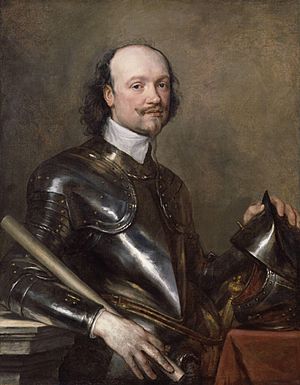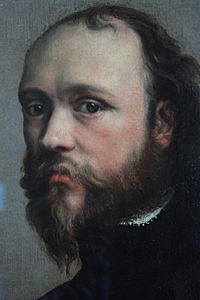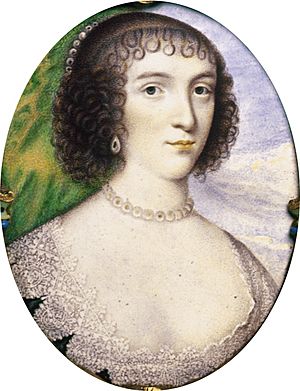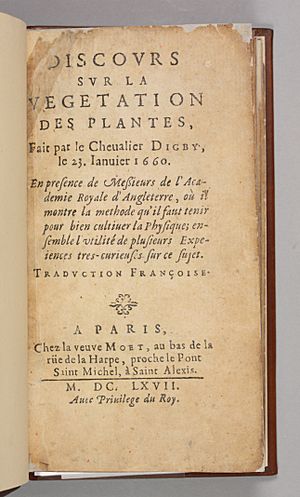Kenelm Digby facts for kids

Sir Kenelm Digby (born July 11, 1603 – died June 11, 1665) was an important English person. He worked as a courtier, which means he served the King, and also as a diplomat. He was known as a smart thinker in natural philosophy, which is like early science. People also knew him as a leading Roman Catholic scholar. One writer called him a "Magazine of all Arts and Sciences," meaning he knew a lot about many different subjects.
Contents
Early Life and Learning
Kenelm Digby was born in Gayhurst, Buckinghamshire, England. His family was from the gentry, a class of wealthy landowners. However, his family's strong Catholic faith affected his life. His father, Everard Digby, was executed in 1606. This was because he was involved in the Gunpowder Plot, a plan to blow up the Parliament.
Despite this, King James I liked Kenelm. He was even suggested to join a special Royal Academy with famous writers like Ben Jonson. Kenelm went to Gloucester Hall, Oxford, in 1618. He studied with Thomas Allen, a mathematician. Kenelm left Oxford without getting a degree. Later, Allen gave his library to Digby, who then gave it to the Bodleian Library at Oxford.
Between 1620 and 1623, Kenelm traveled in Europe. In 1623, he joined Prince Charles's household in Madrid. When he returned to England that same year, King James I made him a Knight Bachelor. He also became a gentleman of the King's private room. In 1624, he received a Master of Arts degree from Cambridge.
Adventures and Discoveries
Around 1625, Kenelm Digby married Venetia Stanley. He later wrote about their courtship in his memoirs. He also became a member of the King's Privy Council. Because his Catholic faith made it hard to get government jobs, he briefly became an Anglican.
In 1627, Digby became a privateer. This meant he sailed his own ship, the Eagle, to capture enemy ships. He sailed to Gibraltar and captured several Spanish and Flemish ships. He also went to Algiers and convinced the leaders there to free 50 English slaves. He won a battle against French and Venetian ships in Iskanderun. After these adventures, he became a naval administrator. He later served as Governor of Trinity House, which helps manage shipping.
His wife, Venetia, was very beautiful. She died suddenly in 1633. This sad event led to a famous painting of her on her deathbed by Van Dyck. Ben Jonson, a famous writer, also wrote a poem about her. Digby was very sad. He went to Gresham College and focused on science. He also returned to the Catholic faith. At Gresham College, he had a lab with a Hungarian chemist, Johannes Banfi Hunyades. They did experiments with plants.
Digby also received special rights from the King. He got the right to be the only seller of sealing wax in Wales. He also had rights to trade with places like the Gulf of Guinea and Canada.
Family Life
Sir Kenelm Digby married Venetia Stanley in 1625. They had six sons:
- Kenelm Jr. (1625–1648), who died in a battle.
- John (1627–?), who was the only son to live longer than his father. He married and had two daughters.
- Everard (1629–1629), who died as a baby.
- Unnamed twins (1632), who were lost before birth.
- George (around 1633–1648), who died from an illness at school.
They also had a daughter named Margery (born around 1625). She married Edward Dudley and had at least one child.
Faith and Difficult Times
Digby became Catholic again in 1635. He moved to Paris, France, and lived there for most of the time until 1660. While in Paris, he met important thinkers like Marin Mersenne and Thomas Hobbes.
He returned to England to support King Charles I. The King was trying to set up a certain church system in Scotland. Digby became less popular with the growing Puritan group. He supported King Charles I's efforts against the Scottish Presbyterians. He left England for France again in 1641. After a difficult event where he was involved in a duel, he returned to England in 1642. He was put in jail by the House of Commons. He was later freed with help from Anne of Austria, the Queen of France. He went back to France and stayed there during the English Civil War. The Parliament took away his property in England.
Queen Henrietta Maria had fled England in 1644. Digby became her Chancellor, a high-ranking official. He tried to get help for the English monarchy from Pope Innocent X, but he was not successful. His son, also named Kenelm, died in a battle in 1648. After Oliver Cromwell took power in England, Digby was seen as a representative for English Catholics. He went on a mission to the Papacy in 1655 to try to find an agreement. This also did not work out.
When the King returned to power in England (the Restoration), Digby was favored because of his connection to Queen Henrietta Maria. However, he sometimes had disagreements with King Charles II. Still, people generally respected him until he died. He passed away a month before his 62nd birthday from a condition called "the stone," likely caused by kidney stones. He was buried next to his wife in London.
His Ideas and Writings
In 1638, Digby published a book called A Conference with a Lady about choice of a Religion. In it, he argued that the Catholic Church was the only true church.
People at the time sometimes thought Digby was a bit unusual. This was partly because of his lively personality. It was also because he was very interested in science. He spent a lot of time studying astrology and alchemy. He even studied alchemy with Van Dyck in the 1630s.
One of his most famous ideas was the powder of sympathy. This was a type of sympathetic magic. People believed you could make a special powder using astrological methods. Then, you would put the powder on the object that caused an injury, not on the injury itself. His book about this special powder was printed 29 times!
In 1644, he published two important books about philosophy: The Nature of Bodies and On the Immortality of Reasonable Souls. These books showed his ideas about Aristotelianism and atomism, which were early scientific theories.
Digby was in touch with the smartest people of his time. They thought highly of him. He was one of the first members of the Royal Society, a famous group for scientists. He was on its governing council from 1662 to 1663. His book Discourse Concerning the Vegetation of Plants (1661) caused some debate among the Royal Society members. It was published in French in 1667. Digby was the first person to notice that "vital air," which is like oxygen, is important for plants to grow. He also had an early idea about photosynthesis.
Digby is also known for a cookbook called The Closet of the Eminently Learned Sir Kenelme Digbie Kt. Opened. It was published in 1669, after he died, by a servant who used his notes. Today, it is a great source for old recipes, especially for drinks like mead. He even tried some of his recipes on his wife, Venetia. One recipe was for capons (a type of chicken) fed on vipers!
Digby is also seen as the inventor of the modern wine bottle. In the 1630s, he owned a glass factory. He made strong, round glass bottles with tall necks. His special way of making glass used a very hot coal furnace. This made bottles that were stronger and more stable. Their green or brown color also protected the wine inside from light. Even though others tried to claim his invention, Parliament recognized his claim in 1662.
In Stories
Sir Kenelm Digby and his wife are characters in the 2014 book Viper Wine by Hermione Eyre.
He is also mentioned in Nathaniel Hawthorne's book The Scarlet Letter. In one chapter, a character named Chillingworth is described as knowing a lot about medicine. He says he worked with Digby and other famous people in science. Digby's scientific skills are called "hardly less than supernatural."
Digby also appears in Umberto Eco's book "The Island of the Day Before" as "Mr. d'Igby." He explains his idea of the sympathetic powder to the main character.






